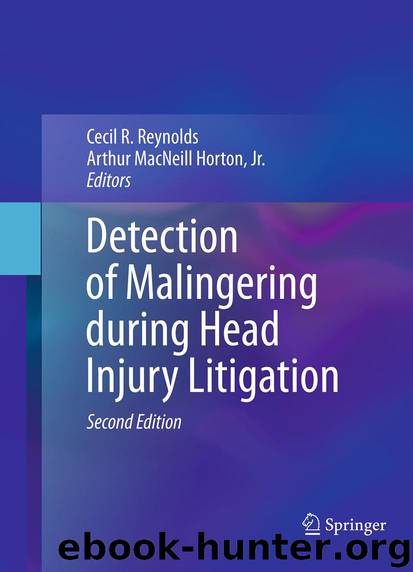Detection of Malingering during Head Injury Litigation by Cecil R. Reynolds & Arthur MacNeill Horton

Author:Cecil R. Reynolds & Arthur MacNeill Horton
Language: eng
Format: epub
Publisher: Springer US, Boston, MA
General Methods for Data Analyses and the Clinical Utility of Symptom Validity Testing
The early studies of malingering were apparently designed to find a reliable and valid method that would utilize worse-than-chance responding, such as the Portland Digit Substitution Test (Binder, 1993). Such a method would represent an extremely specific measure of malingering. A high degree of specificity is crucial because of the social context of assessing malingering. A conclusion that a referred patient is malingering and behaving dishonestly has greater social consequences than a conclusion that the patient’s memory is poor. If worse-than-chance responding was characteristic of every malingering subject and not characteristic of subjects responding honestly, then a very efficient and effective method to detect malingering would have been quickly discovered and available to practitioners. An additional major advantage of such a method is that such a test does not need to be normed and can be easily created by any practitioner with a set of index cards and a marking pen.
Unfortunately, the studies of forced-choice techniques that rely on worse-than-chance responding suggest that very few malingering subjects perform so badly that their response level falls below chance. Few studies found a rate of worse-than-chance responding greater than five percent of the sample asked to malinger. The high expectations for worse-than-chance responding were derived from case reports then became prominent in the early investigation of malingering (Binder & Pankratz, 1987; Pankratz, 1983). These cases probably represented exceptional examples of poor responding.
A number of studies have also used discriminant function analyses to assess the discriminative power of regression-ordered combinations of tests (Bernard, Houston, et al., 1993; Bernard, McGrath, et al., 1993; Heaton et al., 1978; Iverson & Franzen, 1994; Millis et al., 1995; Millis & Putnam, 1994). The studies typically find a very high degree of discriminative power, some approaching 95% correct classification. These high classification rates are misleading. They simply suggest that the performance level of the malingering group is sufficiently different from the comparison groups. The basic problem with them is that these studies do not include patients with moderate and severe impairment levels. The studies usually do not reveal different patterns of performance by the use of discriminant functions. The classification rate increases with the distance in level of performance between the malingering subjects and the group or groups to which they are being compared. If the malingerer simply scores worse than normal subjects and better than brain-injured subjects, then the discriminant functions will appear highly discriminating. Another major difficulty with this method, as it is currently applied, is that investigators have relied almost exclusively on the conventional scoring of the tests used in the analyses. Particular discriminating features of malingering, such as a dissociation between recall and recognition are often obscured by the numerous differences in level of performance on a number of tests and subtests. It is consequently unlikely that discrimination formulas that are created through essentially unguided empirical analyses will render consistent and valid clinical detection methods. The strength of discriminant function analysis will
Download
This site does not store any files on its server. We only index and link to content provided by other sites. Please contact the content providers to delete copyright contents if any and email us, we'll remove relevant links or contents immediately.
Periodization Training for Sports by Tudor Bompa(8170)
Why We Sleep: Unlocking the Power of Sleep and Dreams by Matthew Walker(6618)
Paper Towns by Green John(5091)
The Immortal Life of Henrietta Lacks by Rebecca Skloot(4526)
The Sports Rules Book by Human Kinetics(4294)
Dynamic Alignment Through Imagery by Eric Franklin(4118)
ACSM's Complete Guide to Fitness & Health by ACSM(3989)
Kaplan MCAT Organic Chemistry Review: Created for MCAT 2015 (Kaplan Test Prep) by Kaplan(3940)
Introduction to Kinesiology by Shirl J. Hoffman(3726)
Livewired by David Eagleman(3684)
The Death of the Heart by Elizabeth Bowen(3552)
The River of Consciousness by Oliver Sacks(3541)
Alchemy and Alchemists by C. J. S. Thompson(3451)
Bad Pharma by Ben Goldacre(3357)
Descartes' Error by Antonio Damasio(3230)
The Emperor of All Maladies: A Biography of Cancer by Siddhartha Mukherjee(3068)
The Gene: An Intimate History by Siddhartha Mukherjee(3047)
The Fate of Rome: Climate, Disease, and the End of an Empire (The Princeton History of the Ancient World) by Kyle Harper(3003)
Kaplan MCAT Behavioral Sciences Review: Created for MCAT 2015 (Kaplan Test Prep) by Kaplan(2940)
